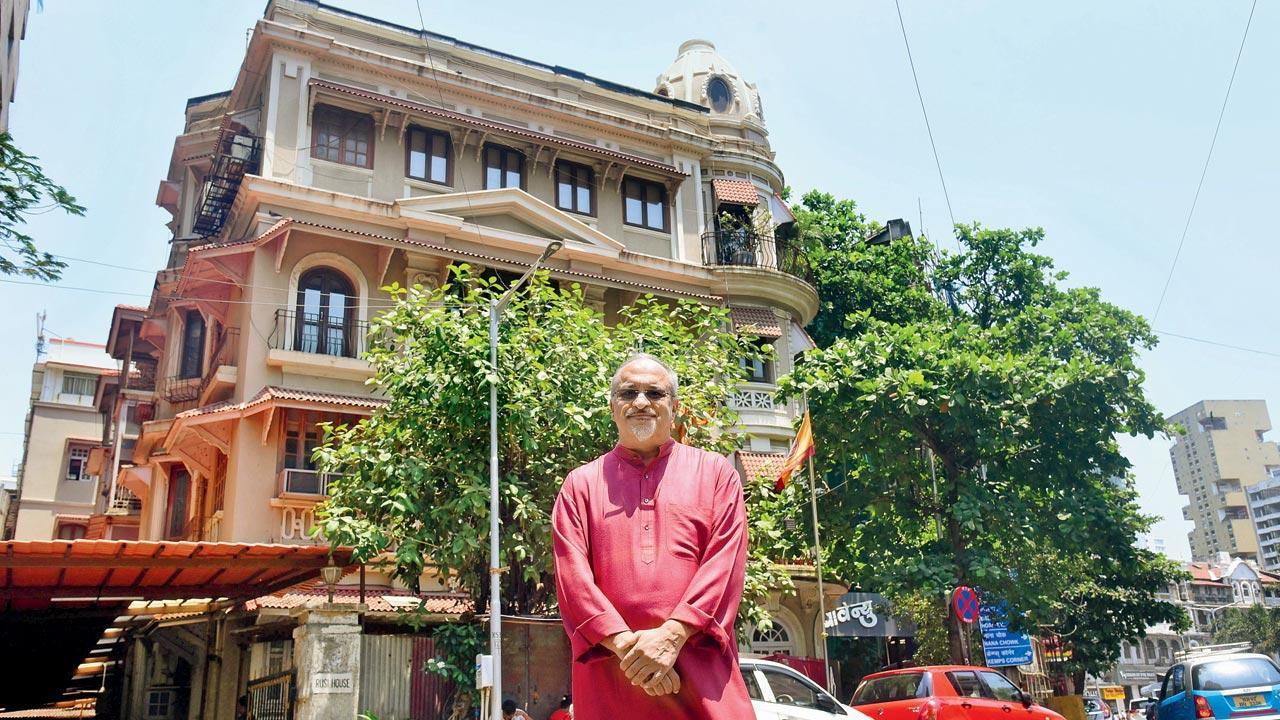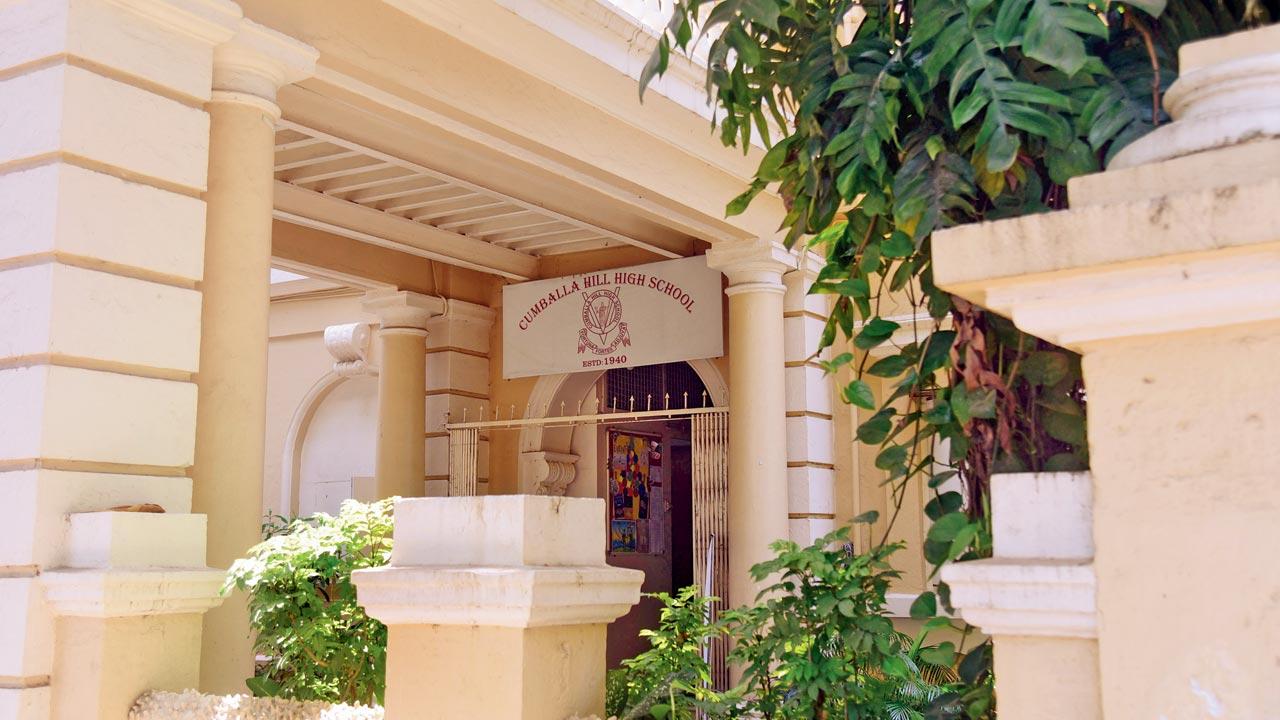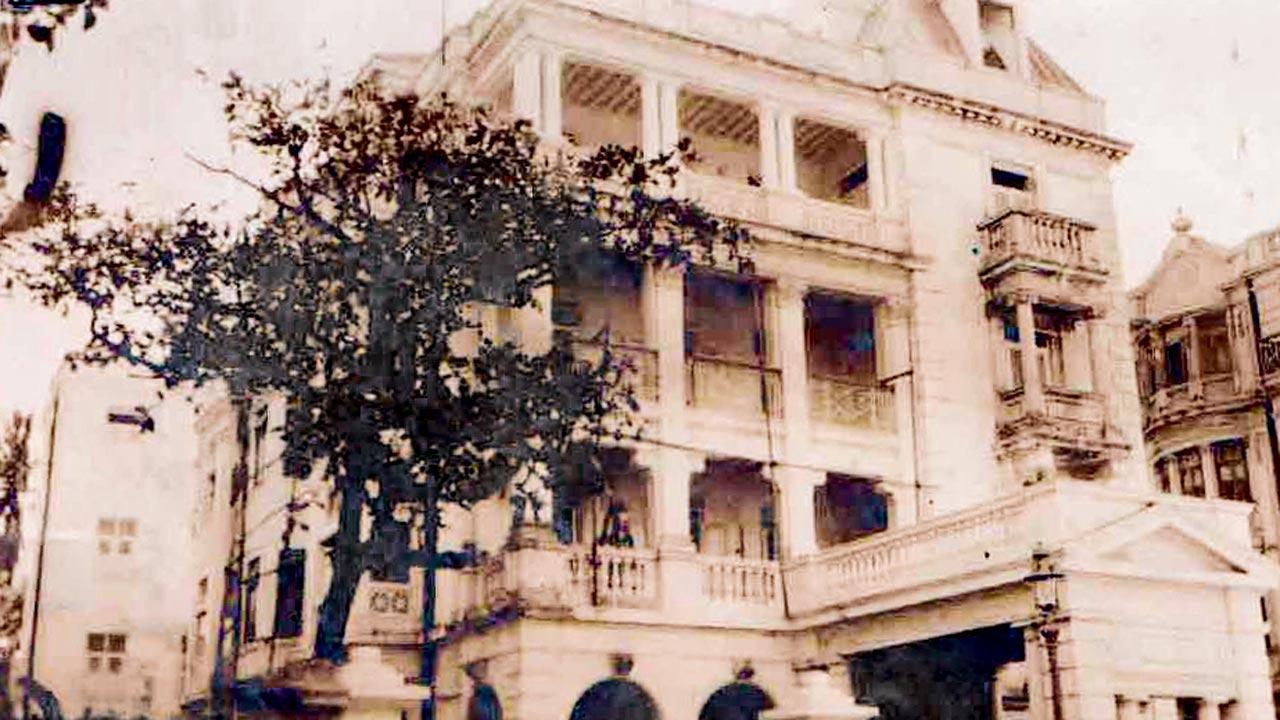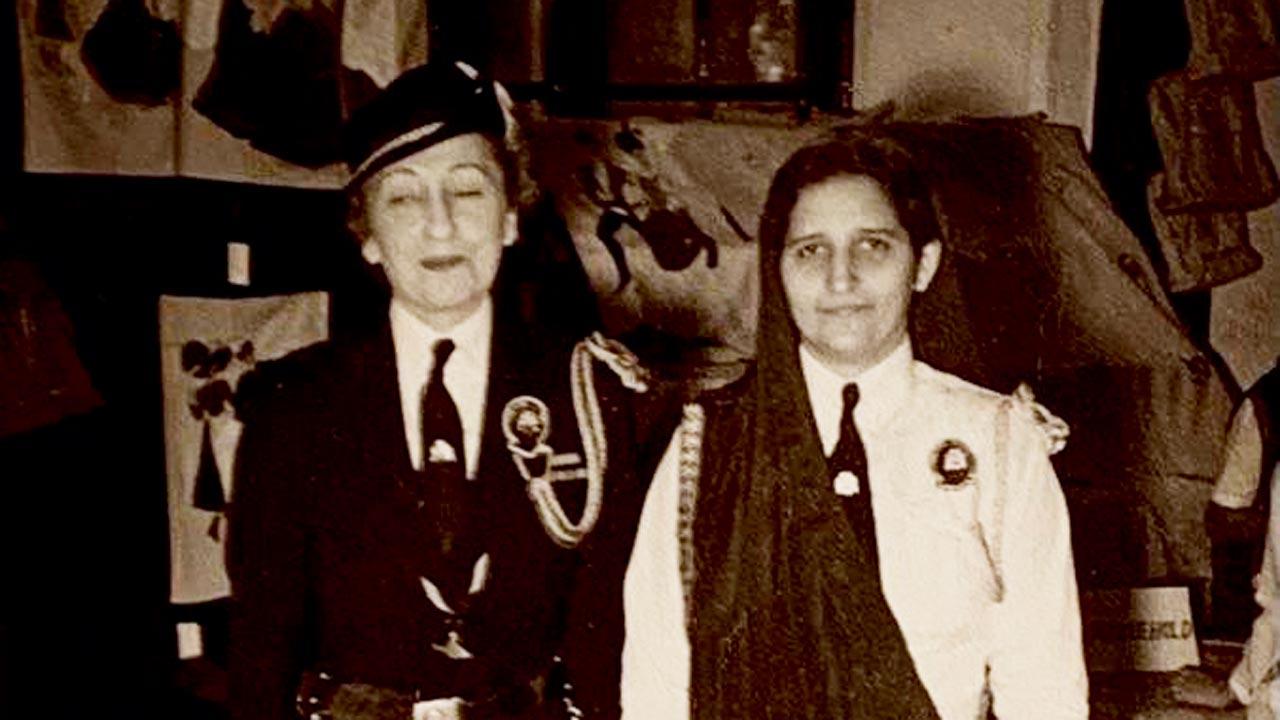A small but historic cul-de-sac finds itself almost fully felled by a builders’ wrecking ball

Dinesh Vazirani outside Rusi House at the Darabsha Lane corner
 Flowers introduced me to Darabsha Lane. Among the half-dozen gullies sprouting west off Napean Sea Road entered from the St Stephen’s Church junction, this is what used to be known as “the Flamour lane”. In a building then simply called The Corner, the prettiest blooms greeted you at the Allanas’ florist shop, Flamour.
Flowers introduced me to Darabsha Lane. Among the half-dozen gullies sprouting west off Napean Sea Road entered from the St Stephen’s Church junction, this is what used to be known as “the Flamour lane”. In a building then simply called The Corner, the prettiest blooms greeted you at the Allanas’ florist shop, Flamour.
While Flamour got swallowed by a tower replacement, Bienvenue Silver House soldiers on across it in Rusi House, one of just four breathtakingly beautiful buildings left on this quiet cul-de-sac. Three others remain. Ruby Mansion, Putla Mansion and Sea Shells. Named after shipping and stevedoring pioneer Darabsha Bomanji Dubash, the lane once led straight to a beach strip of sand and rock hugging the Arabian Sea.
Dappled by gulmohars, barringtonias and badam trees, the lane was rowed with 12 magnificent buildings, now brutally whittled down to this quartet. Elegant without exception, these were erected from the last decades of the 1800s to the 1920s-30s, in design styles classic to hybrid, Renaissance Revivalist to blended Edwardian, Georgian, Victorian and Indo Saracenic.

Closest-to-the-shore Samudra Villa was where Swami Vivekananda was hosted in 1892 by the Sanskrit scholar Ramdas Chhabildas, one of the country’s first barristers. The following year Vivekananda famously represented India and Hinduism at the Parliament of the World’s Religions in Chicago.
Spending two months at Samudra Villa, Vivekananda proceeded north to the Borivli bungalow of Ramdas’ father Chhabildas Lalubhai (who bequeathed the city Chhabildas High School, cradle of Marathi theatre in Dadar). The Kanheri Caves nearby deeply impacted the philosopher.
Excited to learn she later trod the same soil as Vivekananda, writer-translator Aban Mukherji shares interestingly vivid vignettes of Avasia House where she was born. Flanked by Corinthian columns topped by a Greek pediment, the building had a garden lush with fruit trees. So, bats became permanent inhabitants flying in to circle ceilings wildly. A profusion of exotic flowering plants was believed to have been brought by the Avasias, whose building this was originally, from China and Hong Kong. Driveways on both sides burst with huge spider lily bushes.

Entrance to Cumballa Hill High School in Putla Mansion. Pics/Shadab Khan
“We were particularly fond of a flaming yellow-canopied peltophorum. The copper pod branches stretched to touch our second-floor balcony railings,” says Mukherji. “Crows wove nests in it, blue eggs cracking open to pink-mouthed fledglings crying to be fed. A giant jackfruit tree overlooked our dining room windows. The room couldn’t be unattended without risking the crows swoop on breakfast fried eggs and milk with beady-eyed alertness. Sometimes, magpie robins winged in to perch nonchalantly on the sofa.”
Importantly, the seeds of the Bombay Psychiatric Society were sown from Mukherji’s flat. Her psychiatrist father, Dr Kaikhushru AJ Lalkaka, regularly invited Indian and foreign psychologists, psychoanalysts, authors and sociologists to informal after-dinner meetings at which the guest speakers discussed ideas and explored vital mental health breakthroughs. The get-togethers led to the Bombay Psychiatric Society formed in 1965, as well as luncheon discussions at KEM Hospital organised by Dr NS Vahia and Dr VN Bagadia.
Also read: The in-between space
Mukherji’s mother, Pareen Nanavutty, who studied under Madam Montessori when the latter was interned in India during World War II, started a Montessori class in their drawing room. Another Avasia House resident, Mehra Lalkaka, became the first Indian Provincial Girl Guide Commissioner.
 Scenes from now demolished Avasia House: Pareen Lalkaka’s Montessori class
Scenes from now demolished Avasia House: Pareen Lalkaka’s Montessori class
Confessing she was terrified of Cooverbai Avasia, after whom the building was named, Mukherji says, “She sat propped by pillows in a four-poster bed, her face haloed by a thick mop of snowy curly hair, always looking out to shoo ‘naughty boys’ plucking her guavas, chikoos and mangoes on their way back from school. The sight of her legs, swollen with elephantiasis, caused many a childhood nightmare.
“The building was apparently spooked by a lady ghost in white, a headless apparition haunting the rear. Unable to contain my curiosity I bravely marched up the dark back spiral staircase, to be startled out of my wits. It was only a sleepy, bewildered barn owl pinning me with an unblinking stare. I similarly recollect an old Anglo-Indian lady walk from compound to compound, singing Goodnight Irene in a mournful tone.”
Describing scenes as daunting, dancer Shiamak Davar, who grew up in Ruby Mansion, says, “As a kid I was terrified by a mentally challenged man shout loud what sounded like ‘Pray, pray’ in the dead of night between 12 and 6 in the morning. My heart bled too for an auburn-haired young woman pacing up and down pointlessly. Otherwise, ours was a sunny, bright lane, holding pleasures like the bhelpuri wala, aam papad-jeera goli wala and gola sherbet wala. We enjoyed skating at Palm Beach School and street cricket games with my father and friends. My mother watched these matches from our top floor. And I loved visiting my piano teacher just across.”

Mehra Lalkaka (right) the first Indian Provincial Girl Guide Commissioner. Pics Courtesy/Aban Mukherji
This was Dowlat Dhalla of Putla Mansion, who taught music at Cathedral Infant School. Her grandfather Nanabhai Bhiwandiwalla built Putla Mansion in the 1920s. Records from his time confirm a covenant stipulating that no building should exceed an 80 feet height—approximately ground floor plus three storeys.
Tehmi Marazban ran a ragingly popular ballroom dancing class at Putla Mansion, in the vast hall Bhiwandiwalla intended as an entertainment venue. That converted into its current avatar, the Cumballa Hill High School, in the 1960s.
“My mother Dolly Forbes really loved children. She began the story of this school with three pupils on a bench at Kemp’s Corner,” says Bapsy Chubb, who continues to helm the institution at a commendable 91 years. “Her acorn flourished as our oak. I took over as principal from her in the 1980s. ‘All you need is love’, she told me. Layer that with a balance of education and manners, and you can put out generations of good people. With wonderful teachers, we aim for this at Cumballa Hill School.”
Chubb keenly hands me a special issue of the school magazine, Fortuna. “It is printed after several years because of the pandemic. You cannot imagine how tough it was conducting classes online. Admissions dropped but we carry on,” she says with a resolute tilt to the chin. Adding, visibly upset, that builder greed showing no sign of abating, further messes up the lane irrevocably.
“A wall constructed at the end of the lane, supposed to keep kids safe from the sea, soon had slum settlements behind it,” says Dhalla’s son Byram. Besides Mukherji, the Dhallas and Aly Allana who lived at Mehta Mansion, helpfully remember a host of prominent personalities who called Darabsha Lane home.
Leading lights included solicitor Jamshed Lam and his wife Mithan, a Sheriff of Bombay, distinguished for being the first Indian woman barrister and first Indian woman lawyer at Bombay High Court. Mithan and her mother Herabai Tata’s 1911 encounter in Kashmir with British Suffragette, Sophia Duleep Singh, sparked their active involvement in India’s women’s suffrage movement. Mithan and Jamshed’s son was the eminent orthopaedic trauma surgeon Soli Lam.
Other residents of repute were Dr Jerusha Jhirad, one of India’s earliest lady gynaecologists and founder of the reformist Jewish Religious Union in 1925, and theatre veterans Sarita and Praveen Joshi. The Zawawi brothers, Quais and Omar, rose to acquire key posts in the Omani cabinet—respectively as Minister of State for Foreign Affairs and Special Adviser for External Liaison to HM Sultan Qaboos bin Said.
The Limboowalas of Rusi House also owned the building opposite. Two buildings away, Ruby Mansion is associated with such city icons as Bombay Stationery Mart, established by the descendants of Hussonally Abdoolally, and the Davar’s College of Commerce. The Roongtas, proprietors of Famous Studio, and ace AIR commentator Anant Setalvad stayed in Samudra Villa.
Balwantrai Mehta, second Chief Minister of Gujarat and the architect of panchayati raj, would welcome legendary freedom fighters and socialist stalwarts in Morarji Mansion: the likes of Lal Bahadur Shastri, Rafi Ahmed Kidwai, Yashwantrao Chavan and Jayaprakash Narayan.
Belonging to a princely state, the Raja Bagh palace faced Samudra Villa. Its kind maharaja allowed kids to play in his compound till the ground ceded to Palm Beach School. When bolder ones gate-crashed marriage receptions, they returned home with mouths shot red from raspberry drinks telling the tale of truancy—“You went to Raja Bagh again!” parents despaired.
Eagerly awaited Sundays brought a mahout-mounted elephant offering rides and the thrill of watching his trunk tip scoop coins. Madaris flaunted monkeys trained to jive and street acrobats performed audacious feats.
“Everything came together conceptually here: sea views from every terrace, fresh flowers to gift from Flamour, the Headliners salon to groom yourself,” says Dinesh Vazirani, CEO of Saffronart, in his Rusi House apartment. Aptly christened Clouseau sniffs around our heels, canine curiosity peaking to figure how the Vaziranis relocated here easily from the US. “In the heart of this big city, the charm and camaraderie of Darabsha Lane was instantly attractive. A thread seemed to run through its lovely buildings, yet each was architecturally different. Shocking that a perfectly planned path vanishes. Between the towers, even a couple of surviving brownstones hopefully preserve, for a bit, memories of what Bombay was.”
Author-publisher Meher Marfatia writes fortnightly on everything that makes her love Mumbai and adore Bombay. You can reach her at meher.marfatia@mid-day.com/www.meher marfatia.com
 Subscribe today by clicking the link and stay updated with the latest news!" Click here!
Subscribe today by clicking the link and stay updated with the latest news!" Click here!










